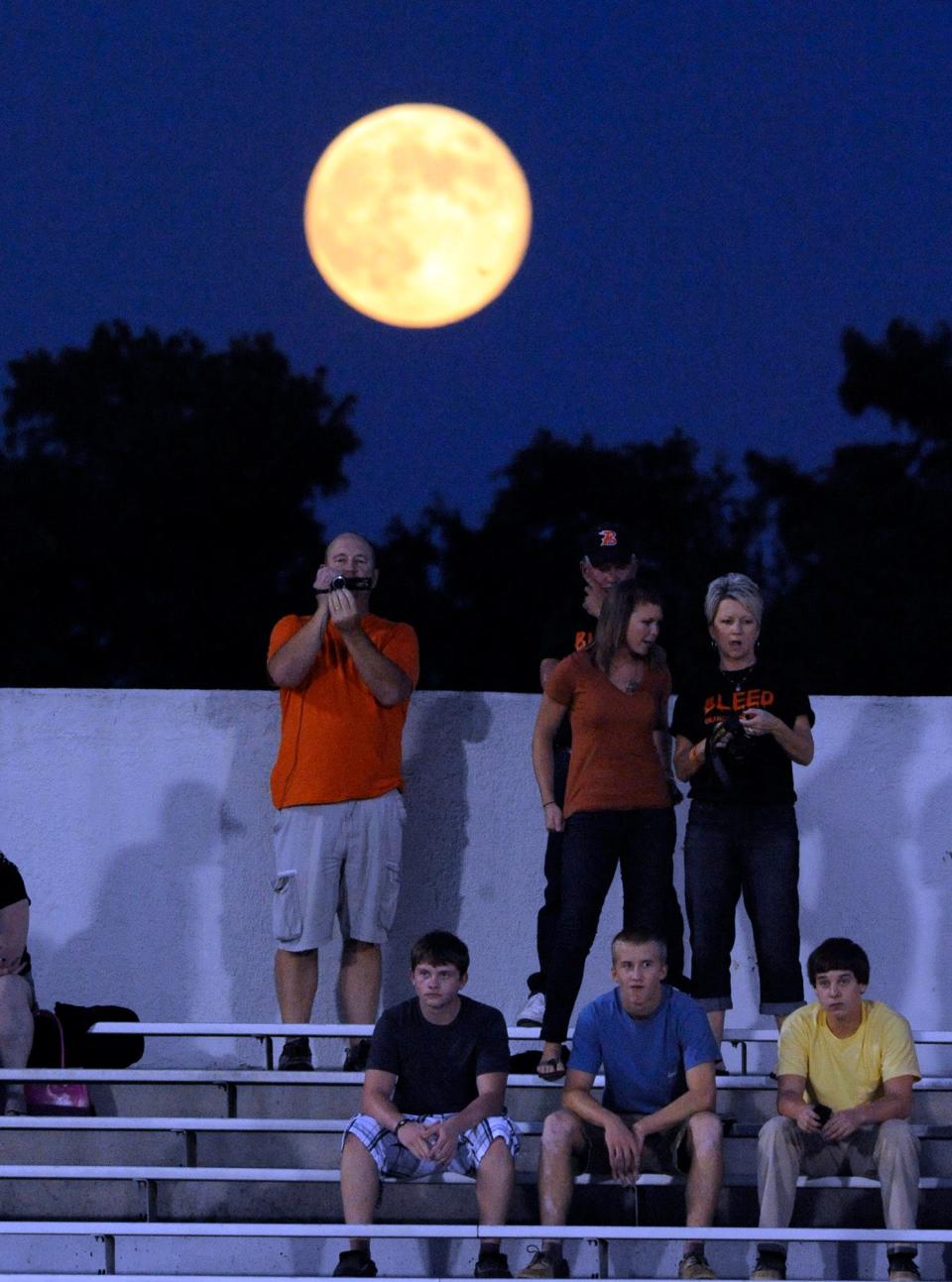What's your moon? A guide to the names and dates of the 2024 full moons
On Jan. 25, the first full moon of 2024 will illuminate the night sky.
Full moons occur approximately every 29 1/2 days when the moon is directly opposite of the sun, according to National Geographic.
While you've likely caught a glimpse of a full moon before, did you know that each month's full moon carries a unique name?
Names of full moons have been passed down generationally by Native Americans and were used to track the seasons, according to The Old Farmer's Almanac.
Here's a list of the names and meanings for each month's full moon and the dates you can expect to spot them in the sky:
Jan. 25: Wolf Moon
The January moon, known as the Wolf Moon, was named after the howling wolves heard during this time of year.
The Old Farmer's Almanac says "many sources state that wolves howled due to hunger." Really, "wolves howl to define their territory, locate other pack members, reinforce social bonds, and gather for hunting."
Alternative names: Canada Goose Moon (Canada Goose Moon (Tlingit), Center Moon (Assiniboine), Cold Moon (Cree), Freeze Up Moon (Algonquin), Frost Exploding Moon (Cree), Great Moon (Cree), Greetings Moon (Western Abenaki), Hard Moon (Dakota), Severe Moon (Dakota), Spirit Moon (Ojibwe)
Feb. 24: Snow Moon
The February moon is named after the weather, as the month is a typical time to see heavy snowfall.
Alternative names: Bald Eagle Moon (Cree), Bear Moon (Ojibwe), Black Bear Moon (Tlingit), Month of the Bony Moon (Cherokee), Eagle Moon (Cree), Goose Moon (Haida), Groundhog Moon (Algonquin), Hungry Moon (Cherokee), Raccoon Moon (Dakota)
March 25: Worm Moon
The Old Farmer's Almanac says this term was originally believed to refer to earthworms spotted in thawing spring soil.
However, in the late 1700s, Jonathan Carver wrote that the name refers to another kind of worm "which emerge from the bark of trees and other winter hideouts around this time."
Alternative names: Crow Comes Back Moon (Northern Ojibwe), Eagle Moon (Cree), Goose Moon (Algonquin, Cree), Snow Crust Moon (Anishinaabe), Sore Eyes Moon (Dakota, Lakota, Assiniboine), Sugar Moon (Ojibwe), Wind Strong Moon (Pueblo)
April 23: Pink Moon
April's full moon is named after a species of wildflower.
The wild ground phlox was "moss pink" in appearance and one of the first wildflowers to sprout in the spring season.
Alternative names: Breaking Ice Moon (Algonquin), Broken Snowshoe Moon (Anishinaabe), Budding Moon of Plants and Shrubs (Tlingit), Frog Moon (Cree), Moon of the Red Grass Appearing (Oglala), Moon When the Ducks Come Back (Lakota), Moon When the Geese Lay Eggs (Dakota), Moon When the Streams are Again Navigable (Dakota), Sucker Moon (Anishinaabe), Sugar Maker Moon (Western Abenaki)
May 23: Flower Moon
The flower moon earned its name from the abundance of blooming flowers during this month.
Alternative names: Budding Moon (Cree), Egg Laying Moon (Cree), Frog Moon (Cree), Leaf Budding Moon (Cree), Planting Moon (Dakota, Lakota), Moon of Shedding Ponies (Oglala)
June 21: Strawberry Moon
In northeastern United States, June is the perfect month for gathering ripe strawberries, according to The Old Farmer's Almanac.
Alternative names: Berries Ripen Moon (Haida), Birth Moon (Tlingit), Blooming Moon (Anishinaabe), Egg Laying Moon (Cree), Hatching Moon (Cree), Green Corn Moon (Cherokee), Hot Moon, Hoer Moon (Western Abenaki)
July 21: Buck Moon
Male deer, known as bucks, shed their antlers each year.
In this month, bucks begin to regrow their antlers, hence this month's full moon name.
Alternative names: Berry Moon (Anishinaabe), Feather Moulting Moon (Cree), Halfway Summer Moon (Anishinaabe), Month of the Ripe Corn Moon (Cherokee), Moon When the Chokecherries are Ripe (Dakota), Raspberry Moon (Algonquin, Ojibwe), Salmon Moon (Tlingit), Thunder Moon (Western Abenaki)
Aug. 19: Sturgeon Moon
North American fishing tribes named the August moon after this fish due to their availability for catch in the Great Lakes and Lake Champlain.
Alternative names: Black Cherries Moon (Assiniboine), Corn Moon (Algonquin, Ojibwe), Flying Up Moon (Cree), Harvest Moon (Dakota), Mountain Shadows Moon (Tlingit), Ricing Moon (Anishinaabe)
Sept. 17: Harvest Moon

Perhaps the most well-known full moon name, the Harvest Moon refers to the time of year when crops are harvested.
This moon is the full moon closest to the autumnal equinox, according to The Old Farmer's Almanac.
Alternative names: Autumn Moon (Cree), Child Moon (Tlingit), Corn Harvest Moon (Dakota), Corn Maker Moon (Western Abenaki), Falling Leaves Moon (Ojibwe), Harvest Moon, Leaves Turning Moon (Anishinaabe), Mating Moon (Cree), Moon of Brown Leaves (Lakota), Moon When the Rice is Laid Up to Dry (Dakota), Rutting Moon (Cree), Yellow Leaf Moon (Assiniboine)
Oct. 17: Hunter's Moon
This month is "when game is fattened up for winter."
The Hunter's Moon is the first full moon following the Harvest Moon. This moon is particularly bright and long, allowing hunters to track their prey at night, according to National Geographic.
Alternative names: Drying Rice Moon (Dakota), Falling Leaves Moon (Anishinaabe), Freezing Moon (Ojibwe), Ice Moon (Haida), Migrating Moon (Cree)
Nov. 15: Beaver Moon
According to National Geographic, origins of this full moon aren't entirely known for certain.
Some say the moon refers to Native Americans use of beaver traps, while others believe the name refers to the high level of activity for the animal in building their winter dams during November.
Alternative names: Deer Rutting Moon (Dakota, Lakota), Digging/Scratching Moon (Tlingit), Freezing Moon (Anishinaabe), Frost Moon (Cree, Assiniboine), Whitefish Moon (Algonquin)
Dec. 15: Cold Moon
The Cold Moon receives its name for the weather of the month of December, which is typically cold with long dark nights.
Alternative names: Drift Clearing Moon (Cree), Frost Exploding Trees Moon (Cree), Hoar Frost Moon (Cree), Little Spirit Moon (Anishinaabe), Long Night Moon (Mohican), Mid-winter Moon (Lakota, Northern Ojibwe), Moon of the Popping Trees (Oglala), Moon When the Deer Shed Their Antlers (Dakota), Snow Moon (Haida, Cherokee), Winter Maker Moon (Western Abenaki)
This article originally appeared on Wilmington StarNews: Full moons of 2024: The dates and names for each month's moon

